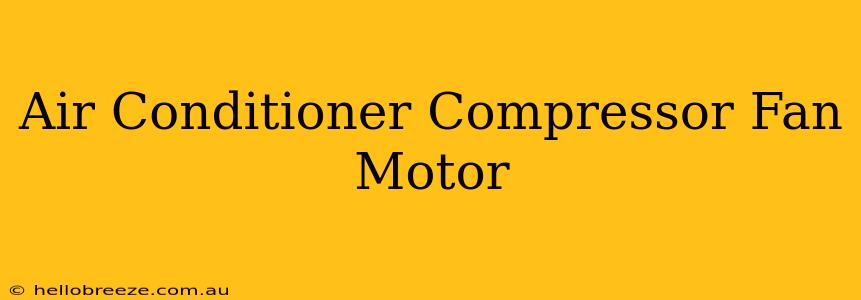Your air conditioner's compressor fan motor is a crucial component, ensuring efficient heat dissipation and preventing overheating. When it malfunctions, your AC unit can struggle to cool effectively, leading to discomfort and potential damage. This guide will walk you through understanding the compressor fan motor, troubleshooting common problems, and exploring potential repair solutions.
Understanding Your Air Conditioner's Compressor Fan Motor
The compressor fan motor is responsible for drawing air across the compressor, which is the heart of your AC system. This airflow is essential for cooling the compressor and preventing it from overheating. A malfunctioning fan motor can lead to several issues, including:
- Reduced Cooling Capacity: The compressor may overheat and shut down, resulting in insufficient cooling.
- Compressor Failure: Overheating can severely damage the compressor, leading to costly repairs or replacements.
- Shorter Lifespan: Continuous overheating can significantly shorten the lifespan of your entire AC unit.
Identifying the Compressor Fan Motor
The compressor fan motor is usually located near the compressor itself, often attached directly to it or housed in a nearby compartment. It's typically a smaller motor compared to the main blower motor responsible for circulating air throughout your home. Consult your AC unit's manual for precise location details.
Common Problems with Air Conditioner Compressor Fan Motors
Several issues can affect your compressor fan motor's performance:
1. Motor Failure:
This is the most common problem. The motor itself may burn out due to age, wear and tear, or voltage surges. Symptoms include:
- No fan operation: The fan simply won't turn on.
- Unusual noises: Grinding, humming, or clicking sounds indicate internal motor problems.
2. Capacitor Failure:
The capacitor provides the initial burst of power needed for the motor to start. A faulty capacitor can prevent the motor from starting or cause it to run erratically. Symptoms include:
- Fan won't start: The motor may hum but fail to spin.
- Intermittent operation: The fan may start and stop unexpectedly.
3. Wiring Issues:
Loose, damaged, or corroded wiring can disrupt the power supply to the motor. Symptoms include:
- No fan operation: A broken wire will prevent power from reaching the motor.
- Intermittent operation: Loose connections can cause inconsistent power flow.
4. Overheating:
Excessive heat can damage the motor windings, leading to failure. This is often linked to other problems, like a clogged condenser coil or refrigerant leaks. Symptoms include:
- Burning smell: A distinct burning odor indicates overheating.
- Motor failure: Prolonged overheating will eventually damage the motor.
Troubleshooting and Repairing Your Compressor Fan Motor
Before attempting any repairs, always disconnect the power supply to the AC unit. This is crucial for your safety.
1. Check the Capacitor:
Use a multimeter to test the capacitor. A faulty capacitor will need replacement. This is a relatively simple repair for someone with basic electrical knowledge.
2. Inspect the Wiring:
Carefully check all wiring connections for looseness, damage, or corrosion. Repair or replace any damaged wires.
3. Examine the Motor:
Visually inspect the motor for any obvious signs of damage, such as burned windings or loose components. A severely damaged motor will likely require replacement.
4. Clean the Condenser Coil:
A clogged condenser coil can restrict airflow, leading to compressor overheating. Clean the coil regularly to ensure proper airflow.
When to Call a Professional
If you're uncomfortable working with electrical components or are unable to identify the problem, it's best to call a qualified HVAC technician. Attempting repairs without proper knowledge can be dangerous and could potentially void your warranty. Replacing the compressor fan motor often requires specialized tools and knowledge.
Remember, regular maintenance of your air conditioning system, including cleaning the condenser coil, is vital for preventing issues with the compressor fan motor and extending the life of your entire unit. By understanding the function of this critical component and following the troubleshooting steps outlined above, you can help keep your AC running efficiently and reliably throughout the summer months.

